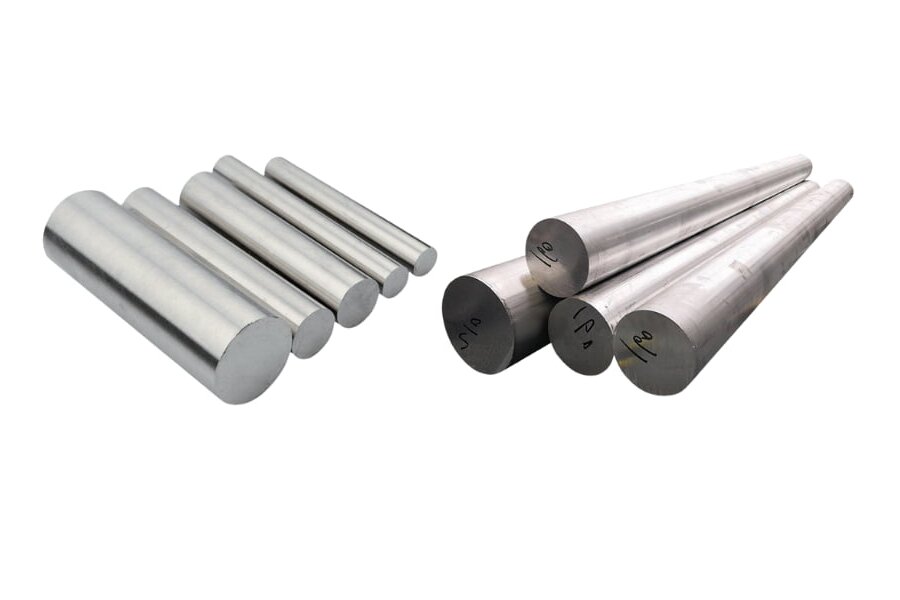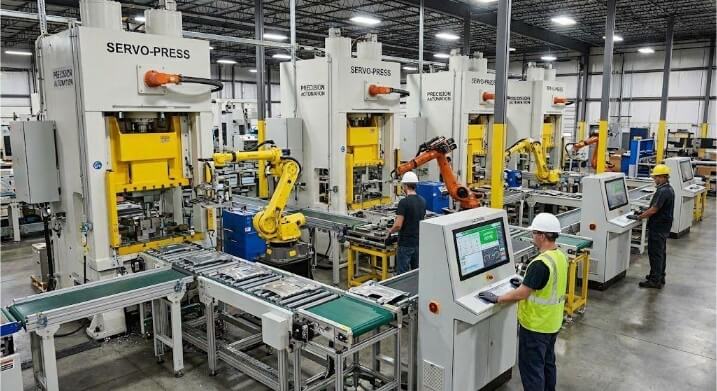금속 선택은 프로젝트의 성패를 좌우할 수 있습니다. 잘못 선택하면 비용이 많이 드는 실수와 수준 이하의 결과물을 피할 수 없습니다. 하지만 적합한 금속을 선택하면 가능성의 세계가 열립니다. 알루미늄과 강철은 각각 고유한 강점을 가진 두 가지 인기 있는 옵션입니다. 그렇다면 어떤 것을 사용해야 할까요?
알루미늄은 경량화와 내식성이 뛰어나며 강철은 강도와 비용 효율성이 뛰어납니다. 두 금속 모두 현대 제조 및 디자인에서 각자의 자리를 차지하고 있습니다. 프로젝트 요구 사항, 예산 제약 및 성능 요구 사항에 따라 선택해야 합니다.
알루미늄과 강철의 주요 차이점을 살펴보세요. 두 소재의 특성, 활용 분야, 장단점을 비교하여 다음 프로젝트를 결정하는 데 도움을 드리겠습니다.

알루미늄 대 강철: 기본 사항 이해
알루미늄: 알루미늄의 특성, 형성 및 장점
알루미늄은 가볍고 은백색의 금속입니다. 알루미늄은 지각에서 세 번째로 풍부한 원소입니다. 알루미늄은 전기분해라는 공정을 통해 보크사이트 광석에서 추출합니다. 이 방법은 광석의 산소 원자로부터 알루미늄을 분리합니다.
알루미늄은 몇 가지 중요한 특성을 자랑합니다. 알루미늄은 강철의 약 1/3에 불과한 밀도로 가볍습니다. 따라서 무게가 중요한 애플리케이션에 이상적입니다. 또한 금속은 부식에 잘 견딥니다. 공기에 노출되면 얇은 산화물 층을 형성하여 기본 금속을 보호합니다.
알루미늄의 다른 장점으로는 열 및 전기 전도성이 높다는 점이 있습니다. 또한 비자성이며 무독성입니다. 이러한 특성 덕분에 다양한 산업 분야에서 활용도가 높습니다.
강철: 강철의 특성, 형성 및 장점
강철은 철과 탄소의 합금입니다. 용광로에서 철광석을 가열하고 탄소를 첨가하여 강철을 만듭니다. 탄소의 양은 강철의 특성에 영향을 미칩니다. 일반적으로 탄소가 많을수록 강도는 높지만 유연성은 떨어집니다.
스틸의 가장 큰 특징은 바로 강도입니다. 인장 강도가 높기 때문에 잘 늘어나거나 부러지지 않습니다. 또한 강철은 알루미늄보다 고온에서도 강도를 잘 유지합니다.
강철은 성형성과 용접성이 우수합니다. 모양을 만들고 결합하기가 비교적 쉽습니다. 또한 금속은 재활용성이 뛰어나 환경적으로도 큰 이점이 있습니다. 강철의 자기적 특성은 전기 애플리케이션에 유용합니다.
알루미늄 대 강철: 비교 분석
무게
무게는 많은 엔지니어링 및 디자인 결정에서 중요한 요소입니다. 여기서 알루미늄이 선두를 차지합니다. 알루미늄은 같은 부피에 비해 무게가 강철의 약 1/3에 불과합니다. 이 때문에 알루미늄은 항공우주 및 자동차 같은 산업에서 가장 많이 선택되는 소재입니다.
운송 분야에서 소재가 가벼울수록 연비가 향상됩니다. 알루미늄은 밀도가 낮기 때문에 과도한 무게 증가 없이 더 큰 구조물을 만들 수 있습니다. 항공기 기체와 자동차 패널에서 알루미늄을 자주 볼 수 있는 이유입니다.
하지만 강철의 무게가 높다는 것은 때때로 단점이 될 수도 있습니다. 여분의 질량은 건물 기초나 중장비와 같은 일부 응용 분야에서 안정성과 고정력을 제공합니다.
힘
강도에 관한 한 강철은 헤비급 챔피언입니다. 강철은 알루미늄보다 높은 인장 강도를 자랑하며, 더 많은 응력을 견디고 부러지기까지 견딜 수 있습니다. 따라서 강철은 하중을 견디는 구조물 및 고응력 애플리케이션에 이상적입니다.
강철의 무게 대비 강도 비율은 인상적입니다. 더 무겁지만 알루미늄과 동일한 구조적 무결성을 달성하는 데 더 적은 재료가 필요한 경우가 많습니다. 따라서 일부 시나리오에서는 무게의 단점을 상쇄할 수 있습니다.
알루미늄은 결코 약하지 않습니다. 많은 알루미늄 합금은 무게 대비 뛰어난 강도를 제공합니다. 그러나 절대 강도가 가장 중요한 분야에서는 일반적으로 강철이 가장 우수합니다.
가단성
알루미늄과 강철은 모두 가단성 금속이지만 작동 방식은 다릅니다. 알루미늄은 일반적으로 강철보다 유연합니다. 금이 가거나 부러지지 않고 복잡한 모양을 만들기가 더 쉽습니다. 이러한 특성 덕분에 알루미늄은 복잡한 디자인이나 얇은 두께의 부품이 필요한 산업에서 인기가 높습니다.
강철은 알루미늄보다 가단성은 떨어지지만 성형성은 여전히 우수합니다. 다양한 합금 원소와 열처리를 통해 가단성을 조절할 수 있습니다. 이러한 다용도성 덕분에 강철은 특정 성형 공정에 맞게 맞춤 제작할 수 있습니다.
알루미늄의 높은 가단성은 스탬핑 및 압출과 같은 제조 공정에서 유리하게 작용할 수 있습니다. 성형에 더 적은 힘이 필요한 경우가 많기 때문에 툴링 비용과 에너지 소비를 줄일 수 있습니다.
열 전도성
알루미늄은 열전도율이 강철보다 뛰어납니다. 열을 더 효율적으로 전달하기 때문에 열교환기 및 냉각 시스템에 탁월한 선택입니다. 이러한 특성 때문에 라디에이터와 에어컨에서 알루미늄을 자주 볼 수 있습니다.
강철의 낮은 열전도율은 일부 시나리오에서는 이점이 될 수 있습니다. 온도 변화에 대한 단열 효과가 더 뛰어납니다. 강철은 건물 건설과 같이 일정한 온도를 유지해야 하는 분야에 적합합니다.
전자제품에서 알루미늄의 높은 열전도율은 부품의 열을 발산하는 데 도움이 됩니다. 이는 노트북이나 스마트폰과 같은 기기의 과열을 방지하는 데 매우 중요합니다.
부식 저항
알루미늄은 내식성이 뛰어납니다. 공기에 노출되면 얇은 산화물 층을 형성하여 기본 금속을 보호합니다. 이러한 자가 치유 특성 덕분에 알루미늄은 녹 및 기타 형태의 부식에 대한 저항력이 뛰어납니다.
강철, 특히 탄소강은 습기와 산소에 노출되면 녹이 슬기 쉽습니다. 하지만 크롬을 함유한 합금인 스테인리스 스틸은 내식성이 뛰어납니다. 알루미늄의 산화물 층과 유사한 보호 크롬 산화물 층을 형성합니다.
해양 환경이나 실외 환경에서 알루미늄의 내식성은 유지보수 비용 절감과 제품 수명 연장으로 이어질 수 있습니다. 강철은 유사한 보호를 위해 추가 처리나 코팅이 필요한 경우가 많습니다.
비용
일반적으로 비용 측면에서는 스틸이 우위에 있습니다. 일반적으로 원자재 비용과 가공 측면에서 알루미늄보다 저렴합니다. 따라서 예산이 주요 관심사인 대규모 프로젝트에서 강철은 매력적인 옵션입니다.
알루미늄의 높은 초기 비용은 일부 애플리케이션에서 더 가벼운 무게와 더 나은 내식성으로 상쇄될 수 있습니다. 제품 수명 기간 동안 알루미늄은 유지보수 및 운송 비용 절감으로 인해 비용 효율성이 더 높을 수 있습니다.
두 금속의 가격 차이는 시장 상황과 글로벌 공급망에 따라 변동될 수 있습니다. 결정을 내릴 때는 항상 현재 가격을 확인하는 것이 좋습니다.
물리적 특성 비교
몇 가지 중요한 물리적 속성을 분석해 보겠습니다:
- 밀도: 알루미늄(2.7g/cm³) vs 스틸(7.85g/cm³)
- 녹는점: 알루미늄(660°C) 대 강철(1370-1530°C)
- 전기 전도도: 알루미늄(3,770만 S/m) vs 스틸(699만 S/m)
- 항복 강도: 알루미늄(7-11 MPa) 대 강철(250-1000 MPa, 등급에 따라 다름)
이러한 차이점은 소재 선택이 중요한 이유를 잘 보여줍니다. 각 금속의 고유한 특성으로 인해 다양한 용도에 적합합니다.
알루미늄 대 스틸: 빠른 비교
다음은 알루미늄과 강철을 표 형식으로 간단히 비교한 것입니다:
| 속성 | 알류미늄 | 강철 |
|---|---|---|
| 무게 | 더 가벼움(강철 무게의 1/3) | 더 무거운 |
| 힘 | 우수한 중량 대비 강도 비율 | 더 높은 절대 강도 |
| 가단성 | 유연성 향상 | 유연성은 떨어지지만 여전히 성형 가능 |
| 열 전도성 | 더 높은 | 낮추다 |
| 부식 저항 | 우수(보호 산화물 층 형성) | 다양함(탄소강 녹, 스테인리스강 내성) |
| 비용 | 일반적으로 더 비싼 | 일반적으로 저렴 |
| 밀도 | 2.7g/cm³ | 7.85g/cm³ |
| 녹는 점 | 660°C | 1370-1530°C |
| 전기 전도도 | 3,770만 S/m | 699만 S/m |
| 항복 강도 | 7-11 MPa | 250-1000MPa(등급에 따라 다름) |
알루미늄 대 강철: 애플리케이션
알루미늄과 강철은 각각 실생활에서 사용할 수 있는 최적의 장소가 있습니다. 이 금속이 진정으로 빛을 발하는 분야를 살펴보겠습니다.
알루미늄이 선두를 차지합니다:
- 항공우주: 가벼운 특성 덕분에 항공기 및 우주선에 이상적입니다.
- 자동차: 자동차 제조업체는 차량 무게를 줄이고 연비를 높이기 위해 이 기술을 사용합니다.
- 전자제품: 노트북, 스마트폰 및 기타 휴대용 장치에서 찾을 수 있습니다.
- 포장: 음료 캔과 식품 용기를 생각해보세요.
스틸이 지배합니다:
- 건설: 고층 빌딩, 교량 및 인프라의 중추입니다.
- 중장비: 굴삭기, 크레인, 산업 장비는 강철의 강도에 의존합니다.
- 어플라이언스: 냉장고나 세탁기와 같은 많은 가정용품은 강철을 사용합니다.
- 도구: 렌치부터 전동 공구에 이르기까지 강철은 가장 많이 사용되는 소재입니다.
두 금속 모두 다양한 산업 분야에서 각자의 자리를 차지하고 있습니다. 선택은 프로젝트의 특정 요구 사항에 따라 달라집니다.
알루미늄 대 강철: 올바른 합금 선택 방법
프로젝트에 적합한 합금을 선택하는 것이 중요합니다. 다음은 알루미늄과 강철 합금 중에서 선택하는 데 도움이 되는 가이드입니다:
프로젝트 요구 사항을 정의합니다:
- 무게 제약
- 필요한 힘
- 내식성 요구 사항
- 예산 제한
- 환경 조건
- 제작 방법
필요할 때는 알루미늄 합금을 고려하세요:
- 경량 솔루션(예: 범용 6061-T6)
- 뛰어난 내식성(예: 해양 환경용 5052)
- 높은 중량 대비 강도 비율(예: 항공우주 애플리케이션의 경우 7075)
- 우수한 열 전도성(예: 열 교환기의 경우 1100)
필요한 경우 강철 합금을 선택하세요:
- 고강도(예: 중장비용 4140)
- 비용 효율성(예: 일반 구조용의 경우 1018)
- 자기적 특성(예: 자기 애플리케이션용 430 스테인리스 스틸)
- 내열성(예: 고온 환경을 위한 310 스테인리스 스틸)
제조 공정을 평가합니다:
고려하다 표면 마무리 옵션을 선택합니다:
- 알루미늄 아노다이징
- 아연 도금 또는 강철용 파우더 코팅
장기 유지 관리를 평가합니다:
- 알루미늄의 자연적인 내식성
- 일부 환경에서 강철의 보호 코팅 필요성
최선의 선택에는 종종 타협이 수반된다는 점을 기억하세요. 모든 요소를 신중하게 검토하여 특정 용도에 맞는 최적의 합금을 찾으세요.
결론
알루미늄과 강철은 각각 강점과 이상적인 용도가 있습니다. 알루미늄은 가볍고 부식에 강한 시나리오에서 탁월하며, 강철은 강도가 높고 비용 효율적인 애플리케이션에서 빛을 발합니다. 무게, 강도, 비용 및 환경 조건의 균형을 고려하여 특정 프로젝트의 요구 사항에 따라 선택해야 합니다. 두 금속 모두 현대의 제조 및 엔지니어링 분야에서 계속해서 중요한 역할을 하고 있습니다.
신뢰할 수 있는 판금 부품 제조업체가 필요하십니까? Shengen은 갈 곳입니다. 우리는 판금 레이저 절단, 절곡, 표면 마감 및 CNC 가공을 전문으로 합니다. Shengen에 연락하세요 오늘 전문가의 도움을 구하세요!
자주 묻는 질문
알루미늄과 강철은 극한의 기상 조건에서 어떻게 작동할까요?
알루미늄은 내식성으로 인해 추운 환경과 해안가에서 더 나은 성능을 발휘합니다. 강철은 극한의 추위에서 부서지기 쉽지만 알루미늄보다 고온에 더 잘 견딥니다. 두 금속 모두 열악한 조건에서 성능을 향상시키기 위해 처리하거나 합금할 수 있습니다.
알루미늄과 강철 중 무엇이 더 오래 지속되나요?
알루미늄은 천연 산화물 층으로 인해 부식성 환경에서 더 오래 지속됩니다. 그러나 스테인리스 스틸과 같은 특정 유형의 강철은 알루미늄의 수명과 비슷하거나 그 이상일 수 있습니다. 두 금속의 수명은 특정 환경과 용도에 따라 크게 달라집니다.
알루미늄은 강철보다 쉽게 깨지나요?
알루미늄은 일반적으로 강철보다 피로 균열이 발생하기 쉽습니다. 하지만 가단성이 뛰어나 부러지지 않고 구부릴 수 있습니다. 강철은 인장 강도가 높기 때문에 고응력 균열에 더 강합니다.
강철과 알루미늄은 얼마나 더 강할까요?
일반적으로 강철은 인장 강도가 알루미늄보다 2~3배 더 강합니다. 그러나 일부 애플리케이션에서는 알루미늄의 무게 대비 강도가 더 우수할 수 있습니다. 정확한 강도 차이는 비교하는 특정 합금에 따라 다릅니다.
안녕하세요, 저는 케빈 리입니다

지난 10년 동안 저는 다양한 형태의 판금 제작에 몰두해 왔으며 다양한 워크숍에서 얻은 경험에서 얻은 멋진 통찰력을 이곳에서 공유했습니다.
연락하세요

케빈 리
저는 레이저 절단, 굽힘, 용접 및 표면 처리 기술을 전문으로 하는 판금 제조 분야에서 10년 이상의 전문 경험을 갖고 있습니다. Shengen의 기술 이사로서 저는 복잡한 제조 문제를 해결하고 각 프로젝트에서 혁신과 품질을 주도하는 데 최선을 다하고 있습니다.




